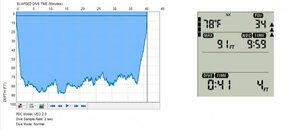Hey folks one case study has me thinking.
Senario is.--drift dive You leading and an instructor is with you. 6 certified "customer" divers
One diver uses a lot more air than normal and gets to 500psi after 25 minutes.
No issues with air checks etc
depth is roughly 24m/80 feet.Low air customer not happy with being politely asked to head up towards the surface.
Instructor escorts the diver to the surface directly ie skips safety stop.
My question is was that the best action on the part of the Instructor?
Maybee Im missing something but at 500psi I would have thought the instructor would have put the customer on his (the instructors) octi ,proceded to the safety stop then had the diver go back to their own air during the safety stop and final ascent.
What have I missed?
Senario is.--drift dive You leading and an instructor is with you. 6 certified "customer" divers
One diver uses a lot more air than normal and gets to 500psi after 25 minutes.
No issues with air checks etc
depth is roughly 24m/80 feet.Low air customer not happy with being politely asked to head up towards the surface.
Instructor escorts the diver to the surface directly ie skips safety stop.
My question is was that the best action on the part of the Instructor?
Maybee Im missing something but at 500psi I would have thought the instructor would have put the customer on his (the instructors) octi ,proceded to the safety stop then had the diver go back to their own air during the safety stop and final ascent.
What have I missed?
Last edited:





